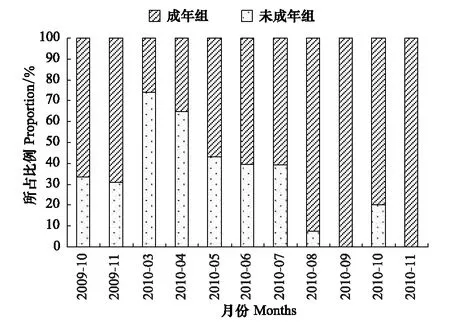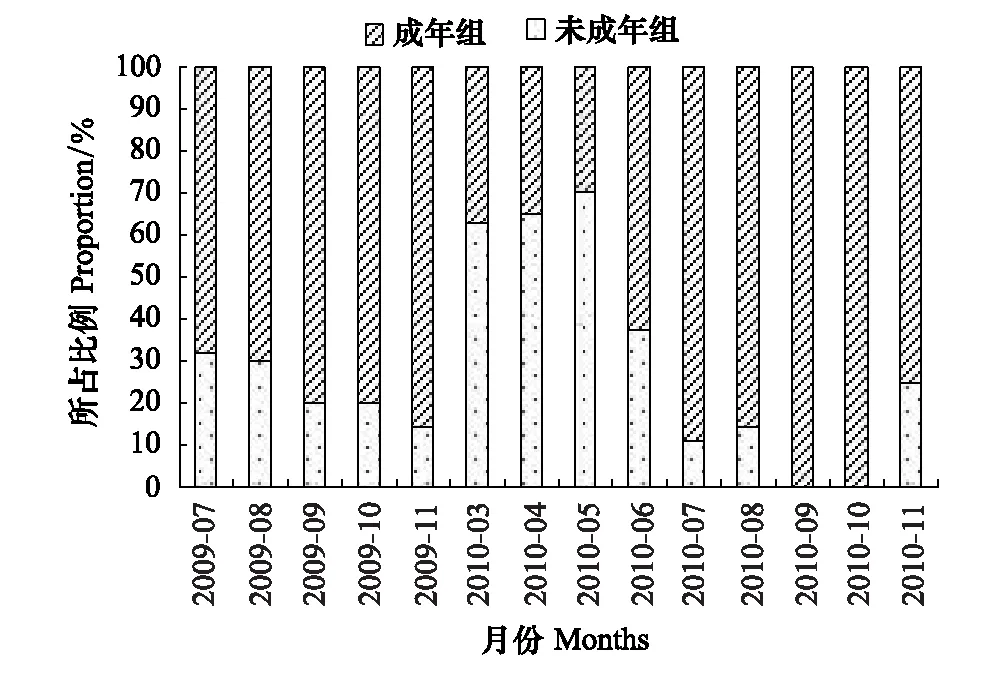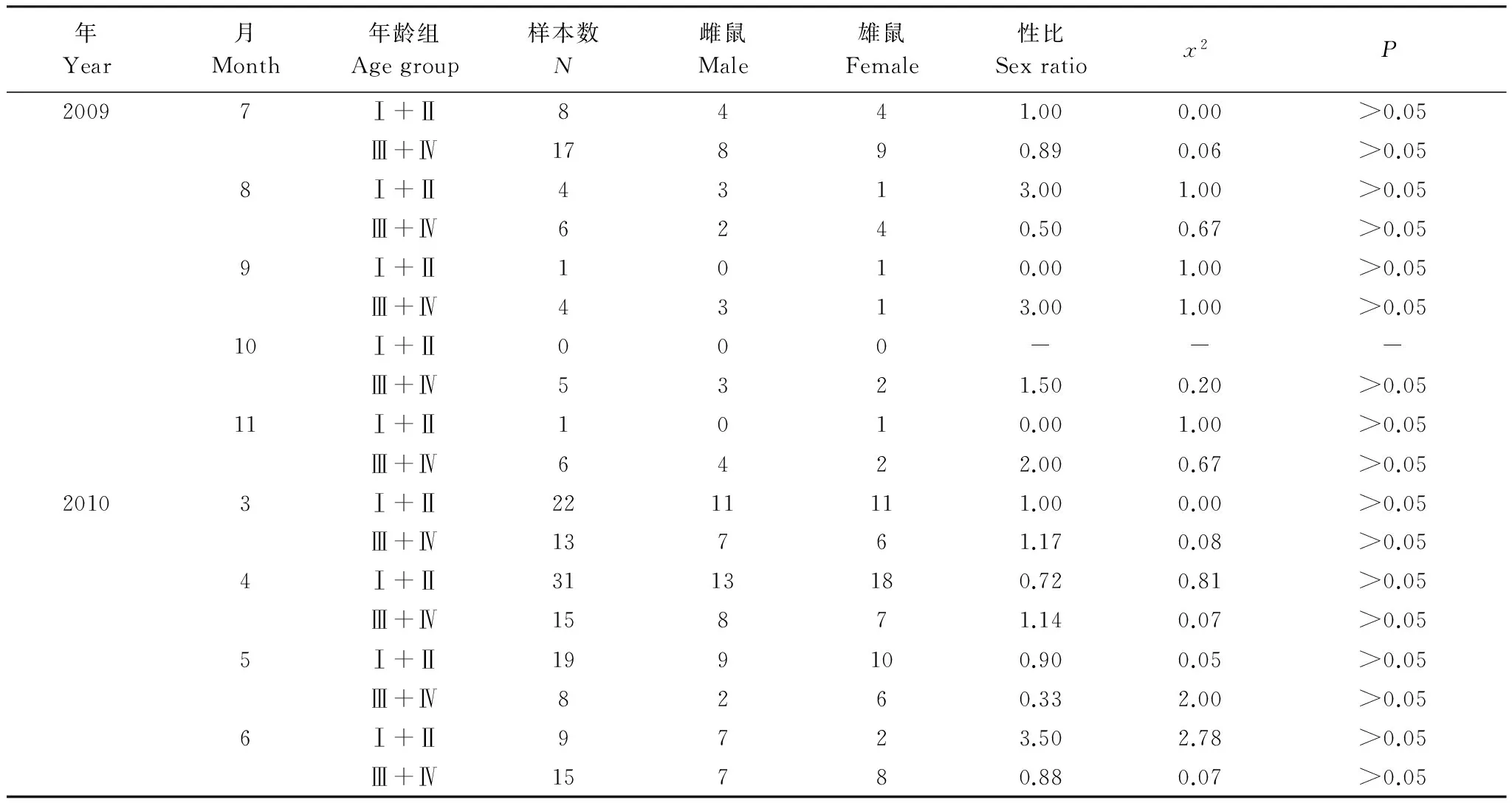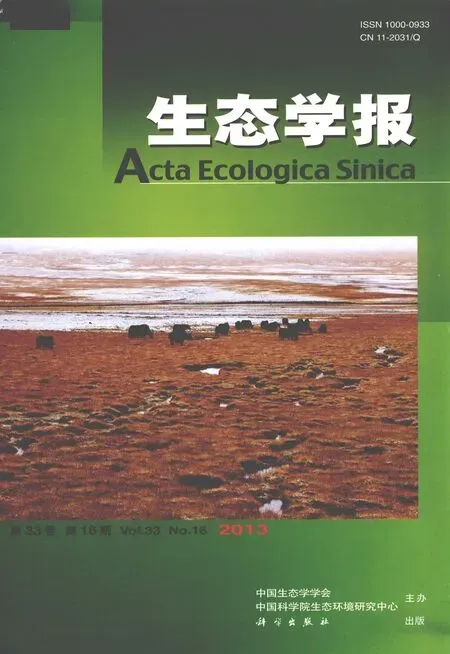千岛湖岛屿社鼠的种群年龄结构和性比
张 旭,鲍毅新,刘 军,沈良良,叶 彬,施渭渭
(浙江师范大学生态研究所,金华 321004)
千岛湖岛屿社鼠的种群年龄结构和性比
张 旭,鲍毅新*,刘 军,沈良良,叶 彬,施渭渭
(浙江师范大学生态研究所,金华 321004)
2009年7月至11月以及2010年3月至11月在千岛湖地区2个岛屿上对社鼠(Niviventerconfucianus)种群进行标志重捕,通过对社鼠种群年龄结构和性比的研究,探讨陆桥岛屿环境下生境片段化对社鼠种群结构的影响。结果显示:社鼠种群年龄结构整体上均表现为由上半年幼年组和亚成年组占优势逐渐过渡到下半年成年组和老年组占绝对优势,岛屿环境对社鼠年龄结构变化的影响与陆地环境有所不同;两岛社鼠种群数量与性比(♀∶♂)之间均存在显著的负相关性(B岛2010年7—11月除外),当种群数量处于高峰期时,雌性少于雄性,而种群数量处于低潮期时,雌性多于雄性,这可能是社鼠种群数量变动内部调节机制的一种表现;由于9—10月和2—3月的繁殖高峰以及高的胎仔数,翌年上半年种群数量就能恢复并达到全年最高峰。
年龄结构;性比;社鼠(Niviventerconfucianus);千岛湖岛屿
动物的年龄结构组成是了解种群动态的重要内容之一,它不仅能够反映种群的数量变动规律,而且对预测种群未来的发展趋势具有重要作用[1- 2]。性比是反映动物种群的基本特征之一,其改变会影响动物的种群结构、配偶竞争和繁殖[3- 4],还会影响种群的密度和大小[5- 6],因此种群的性比在种群生态学的研究中具有重要意义。
社鼠(Niviventerconfucianus)为东洋界常见小型啮齿类动物,分布在我国大部分地区[7- 8]。国内在种群生态方面,从社鼠的种群数量变动[9- 10]、年龄鉴定与年龄结构[10- 13]、性比与繁殖[13- 14]、肥满度[15- 16]、空间分布格局[17]等方面进行了一系列的研究。
生境片段化是指在人为活动和自然干扰下,大块连续分布的自然生境,被其它非适宜生境分隔成许多面积较小生境斑块的过程[18- 19]。因适宜生境斑块面积的减少,种群的规模变小,各种随机因素对种群的影响随之增大,近亲繁殖和遗传漂变潜在的可能性增加,种群的遗传多样性下降,影响到物种的存活和进化潜力[20],进而影响物种的种群动态。
目前国内在昆虫[21]、两栖类[22- 23]、爬行类[24- 25]、鸟类[26- 30]、小型兽类[13,16,31- 33]、大型兽类[34- 36]等方面均开展了对生境片段化的研究。但在片段化生境下,对于动物种群数量与种群结构之间关系的研究尚未见报道。岛屿化是典型的片段化生境[37],因此,选取千岛湖岛屿对社鼠的年龄结构和性比进行研究,消除岛屿间的迁移和扩散等因素对其影响,旨在探讨岛屿隔离对社鼠种群种群结构的影响及种群结构与种群数量之间的关系。
1 研究方法
1.1 标志重捕
由于冬季12月至翌年2月温度较低,鼠类在鼠笼内时间过长而冻死会导致研究个体的丧失,因此未进行重捕。为了获得重复数据和便于对比分析,选取了千岛湖地区面积适当、生境类型相似的两个岛屿作为研究样地。对A岛(2009年10月 — 11月以及2010年3月 — 11月)和B岛(2009年7月 — 11月以及2010年3月 — 11月)的社鼠种群进行标志重捕,所得数据采用修正Lincoln指数法计算两个岛屿上的社鼠种群数量。样地概况、标志重捕以及数量计算的方法已在《陆桥岛屿环境下社鼠种群数量的估算方法》[38]中做了详细介绍,在此从略。
1.2 年龄组划分
根据体重将社鼠划分为幼年组、亚成年组、成年组和老年组4个年龄组,对应的体重分别为lt;35,35—50,50—80.0,gt;80.0 g[10- 11],并参考后足长为第二指标进行纠正。
1.3 数据处理
采用SPSS 17.0数据分析软件对数据进行统计分析。采用x2检验性比与理论值1∶1的差异性。相关性分析均采用线性回归。显著和极显著水平分别为P≤0.05和P≤0.01。作图均采用Excel 2003软件进行。
2 结果
2.1 种群年龄结构
由于取样过程中幼年组及老年组个体捕获较少,因此将幼年组和亚成年组合并为未成年组,成年组和老年组合并为成年组。从两岛社鼠种群年龄结构来看(图1,图2),整体上均表现为由上半年未成年组占优势逐渐过渡到下半年成年组占绝对优势,季节变化较明显。
2.2 种群雌雄性比
2.2.1 雌雄性比与种群数量的关系


图1 A岛各月社鼠的种群年龄结构Fig.1 The age structure in each month in A island

图2 B岛各月社鼠的种群年龄结构Fig.2 The age structure in each month in B island

图4 B岛各季节社鼠性比(♀∶♂)Fig.4 The sex ratio(♀∶♂)in each seasonin B island
2.2.1 不同年龄组的性比
在野生动物种群研究中,可按生活史的不同阶段将种群性比分为初级性比,即胚胎时期的性比;次级性比,即个体出生时的性比;三级性比,即个体幼年时期的性比;四级性比,即个体成年时期的性比。本研究中可将社鼠性比分为三级性比(幼年组及亚成年组)和四级性比(成年组及老年组)。虽然除A岛2010年6月外,两岛其他月份三级性比和四级性比差异均不显著,但是各月不同的年龄组内,性比还是不相同的(表1和表2)。
3 讨论
3.1 陆桥岛屿环境对社鼠种群年龄结构的影响
本研究中9—10月处于千岛湖岛屿社鼠的繁殖期,较早于同纬度其他地区[13],该时期生产的幼体和少部分亚成体,到翌年3—4月基本发育成了亚成体和成体;再由于长江流域及以南部分地区社鼠2—3月便进入繁殖,因此3—4月当年生未成年个体所占比例较大。由于社鼠出生30日后即发育完善,能独立生活[39],而3—4月未成年个体的高比例,也反映出2—3月可能是千岛湖社鼠的繁殖高峰。同纬度地区的浙江天目山社鼠种群年龄组成为幼年鼠在5月开始捕得,8月达到高峰,成为该月的优势组;亚成年鼠在7月、10月到翌年1月均占优势,12月的比例最高;2—5月成年鼠占优势,而以3月为高峰。老年鼠在6月所占的比例有所增加,而在10—12月和1—3月数量趋向减少[39],显然与本研究结果相差较大。因此,陆桥岛屿环境对社鼠种群的年龄结构是有一定影响的。

表1 A岛各月不同年龄组社鼠的性比

表2 B岛各月不同年龄组社鼠的性比
种群的年龄结构能够反映种群的数量变动及种群未来的发展趋势[1],是了解种群数量动态的重要内容之一。孙儒泳[40]认为:种群中幼年期的高比例意味着种群将增长。两岛10—11月幼年组开始出现,加之3—4月未成年期的高比例,使种群在上半年增长达到高峰值。Boonstra[41]及Tkadlec[42]等发现,在种群高峰期过后,种群的年龄结构向较老的个体偏移,这是在波动的啮齿动物种群内普遍存在着的种群统计学过程。由于衰老,种群的衰减是不可避免的,这最终会导致种群下半年的低数量期。
3.2 陆桥岛屿环境对社鼠种群雌雄性比的影响
性比在不同的物种、或同一物种在不同的时期和条件下都会有极大的不同[43- 44]。当种群处于下降期时,雌性少于雄性;而种群处于上升期时,雌性多于雄性。一些研究表明,小型啮齿动物幼体的存活率与补充数受繁殖期雌体密度、行为等影响,而雄体密度对其影响较小,甚至无影响[45- 47]。社鼠在种群增长过程中,雌性对于种群增长的贡献可能相比雄性要大,因此种群增长阶段雌性要多于雄性[10]。在对布氏田鼠(MicrotusbrandtiRadde)[48]、野生小家鼠(Musmusculs)[49- 50]和黑线仓鼠(Cricetulusbarabensis)[51]种群生态学研究也发现,数量处于上升期时性比中雌性比例增大,可能为低数量期的种群特征。这一生殖特性很可能是生态寿命较短的小型兽类在低数量期的种群特征。卢浩泉等[6]也指出,性比对种群繁殖潜力起着明显的影响作用,而这是属于种群数量变动内部调节机制的一种表现。在片段化生境中维持种群的稳定,雌性的作用可能显得更为突出。
有研究表明,一生可多次繁殖的动物由于其雄性有多次参与繁殖的机会,其在一次竞争雌性失败后还有可能在下次生殖时获得机会,种群中处于相对从属地位的雄性个体的最佳繁殖对策应该是提高自身的存活率[52]。因此,本研究中,在非繁殖期的夏季雄性个体的存活率要大于雌性,雌雄性比较低。
种群在不同生活史阶段性比有一定变化,对于兽类来说随着年龄的增长,雄性个体逐渐减少,老年组中雌性个体偏多[53]。而在本研究中,各月三级性比和四级性比并不完全遵循此规律。动物的性比受多种因素的影响,不仅存在季节、年间以及地理变化的差异,而且受环境条件(如气温和降水量)的影响[43]。生境片段化使外界因素对种群的影响作用明显加强,种群结构变得相对脆弱[13]。因此,岛屿较小的面积对社鼠种群的性比结构会产生一定的影响。
捕食风险也是影响性比的主要因素之一,虽然许多动物出生时的性比是一样的,但由于捕食者在捕食猎物的过程中存在明显的选择性,使其性比发生了变化[54]。大部分研究表明,天敌食物当中鼠类雄性要多于雌性[55]。一般解释为雄性活动较多所致,使其有更多的机会暴露在天敌面前。对这两岛社鼠巢区面积大小的研究表明,夏季雄性社鼠的巢区面积极显著大于雌性社鼠[32]。此外,破碎的生境降低了原来生境隐蔽物的效能,因此增加了捕食率[13]。2010年夏季B岛野猪的存在,可能就是导致该岛雌雄性比较高的原因之一。
对大多数动物而言,由于生存资源丰富和匮乏的周期性交替,因此必须将高耗能的繁殖行为限制在每年的特定时段,从而产生了季节性繁殖的现象[56]。根据孙波等[13]对千岛湖中型岛屿的研究表明,9—10月为千岛湖社鼠秋季繁殖的主要月份,平均胎仔数达到5.17只,均明显高于相近纬度浙江金华社鼠的3.77只[57]和洞庭湖区的3.7只[14],与纬度较高的北京地区的5.2只[10]和天津地区的4.5只[58]相接近。9—10月岛屿上社鼠处于低数量期,为了维持种群稳定和繁衍成功,种群就会维持较高的繁殖强度来弥补种群数量的损失[59]。而此时社鼠的胎仔数更高,其原因可能是其种群对岛屿环境适应的结果。由于9—10月的繁殖,到翌年3月社鼠种群就会增长到较高水平。由于长江流域及以南部分地区社鼠2—3月便进入繁殖[60],因此4—6月就会出现全年数量的最高峰。
[1] Li J,Abulimit A. Study on the age identification and the population age composition ofMerioneslibycus. Arid Zone Research, 2007, 24(1): 43- 48.
[2] Yang Z X, Zheng Y L, Jin X. Species reproductive parameters and the comparison of geography variation inApodemusagrarius. Acta Ecologica Sinica, 2007, 27(6): 2425- 2434.
[3] McGovern M T. Sex ratio bias and clonal reproduction in the Brittle StarOphiactissavignyi. Evolution, 2002, 56(3): 511- 517.
[4] Prohl H. Population differences in female resource abundance, adult sex ratio, and male mating success inDendrobatespumilio. Behavioral Ecology, 2002, 13 (2): 175- 181.
[5] Yang H F, Wang S Q. Effect of population density, sex ratio on population numbers of rodents Ⅰ. effect of population densities, sex ratio on reproduction in female mice. Acta Theriologica Sinica, 1984, 4(4): 301- 309.
[6] Lu H Q, Li Y C, Zhang X D. Age determination, age structure and population dynamics of striped hamster. Acta Theriologica Sinica, 1987, 7(1): 28- 44.
[7] Zhang R Z. Physical Geography of China: Animal geography. Beijing: Science Press, 1979: 62- 70.
[8] Wang S,Zheng C L. On the subspecies of the Chinese sulphur bellied rat:RattusniviventerHodgson. Sinozoologia, 1981, 1:1- 8.
[9] Bao Y X, Zhuge Y. A preliminary survey rodents Tian-mu mountain nature reserve. Acta Theriologica Sinica, 1984, 4(3): 197- 205.
[10] Zhang J. Studies on the population ecology of sulphur bellied rat. Acta Theriologica Sinica, 1993, 13(3): 198- 204.
[11] Bao Y X, Zhuge Y. The age estimation and age structure in the population of rattusNiviventerconfucianus. Acta Theriologica Sinica, 1984, 4(2): 127- 137.
[12] Wang Y, Hu J C, Shen L M. Regression analysis on age structure ofNiviventerconfucianuspopulation. Sichuan Journal of Zoology, 2003, 22(3): 159- 162.
[13] Sun B, Bao Y X, Zhang L L, Zhao Q Y. Age-structure and reproduction investigation onNiviventerconfucianusliving on islands at Qiandao Lake in autumn. Acta Theriologica Sinica, 2009, 29(3): 112- 119.
[14] Zhang M W, Huang H, Wang Y, Li B. Reproductive ecology of sulphur bellied rat (Niviventerconfucianus) populations in the Dongting Lake region. Acta Ecologica Sinica, 2006, 26(3): 884- 894.
[15] Gao F, Bao Y X. The comparison and analysis of relative fatness ofRattusNiviventerbetween Zhoushan island and Jinhua north mountain. Acta Theriologica Sinica, 1995, 15(4): 272, 309.
[16] Sun B, Bao Y X, Zhang L L, Zhao Q Y, Hu Z Y. Preliminary study on relative fatness ofNiviventerconfucianuson islands of Qiandao Lake region. Zoological Research, 2009, 30(5):545- 552.
[17] Wang Y, Hu J C, Shen L M. Study on the spatial pattern ofNiviventerconfucianusin the Tang-jiahe Nature Reserve. Sichuan Journal of Zoology, 1994, 13(2): 67- 68.
[18] Wilcox D S, McClellan C H, Dobson A P. Habitat fragmentation in the temperate zone // Conservation Biology: The Science of Scarcity and Diversity. Sunderland Massachusetts: Sinecure Associates Inc, 1986.
[19] Lovejoy T E, Bierregaard R O, Rylands A B. Edge effects and other effects of isolation on Amazon forest fragments // Conservation Biology: The Science of Scarcity and Diversity. Sunderland Massachusetts: Sinecure Associates Inc, 1986.
[20] Wu Z J, Li M Y. Effects of habitat fragmentation on survival of animal populations. Acta Ecologica Sinica, 2003, 23(11): 2424- 2435.
[21] Yang P, Deng H L, Qi B. The occupied rate of microhabitats, sampled percentage of species and relative abundance of butterfly community in the Three Gorge Reservoir Area of Yangtze River. Acta Ecologica Sinica, 2005, 25(3): 543- 554.
[22] Li Y M, Li D M. An analysis of main factors affecting species diversity for Raniformes on Zhoushan Archipelago. Acta Zoologica Sinica, 1998, 44(2): 150- 156.
[23] Ma X M, Gu H Q. Studies on distribution and population number ofHynobiuschinensison the Zhoushan Island. Sichuan Journal of Zoology, 1999, 18(3): 107- 108.
[24] Shou L, Du W G, Lu W W. The causal analysis of inter-population variation in life histories of the northern grass lizardTakydromusseptentrionalis: between-island differences in thermal environment, food availability and body temperature. Acta Zoologica Sinica, 2005, 51(5): 797- 805.
[25] Wang Y P, Zhang J C, Feeley K J, Jiang P, Ding P. Life history traits associated with fragmentation vulnerability of lizards in the Thousand Island Lake, China. Animal Conservation, 2009, 12(4): 329- 337.
[26] Zhang J C, Wang Y P, Jiang P P, Li P, Yu M J, Ding P. Nested analysis of passeriform bird assemblages in the Thousand Island Lake region. Biodiversity Science, 2008, 16(4): 321- 331.
[27] Wang Y P, Bao Y X, Yu M J, Xu G F, Ding P.Nestedness for different reasons: the distributions of birds, lizards and small mammals on islands of an inundated lake. Diversity and Distributions, 2010, 16(5): 862- 873.
[28] Zhang M, Sun J J, Wang Y P, Jiang P P, Ding P, Xu G F. Effects of habitat fragmentation on the use of nest site resources by great tits in Thousand Island Lake, Zhejiang Province. Biodiversity Science, 2010, 19(4): 383- 389.
[29] Wang Y P, Chen S H, Ding P. Testing multiple assembly rule models in avian communities on islands of an inundated lake, Zhejiang Province, China. Journal of Biogeography, 2011, 38(7): 1330- 1344.
[30] Sun J J, Wang S Y, Wang Y P, Shao D Y, Ding P. Effects of habitat fragmentation on avian nest predation risk in Thousand Island Lake, Zhejiang Province. Biodiversity Science, 2011, 19(5): 528- 534.
[31] Zhao Q Y, Bao Y X, Sun B, Zhang L L, Hu Z Y. Analysis of the small mammals community diversity in the Qiandao Lake region. Acta Theriologica Sinica, 2009, 29(4): 406- 412.
[32] Shen L L, Bao Y X, Zhang X, Wei D Z, Liu J. Effect of different seasons and sex ofNiviventerconfucianuson islands at Thousand Island Lake. Journal of Zhejiang Normal University (Natural Science), 2011, 34(3): 328- 332.
[33] Liu J, Bao Y X, Zhang X, Lin J J, Ye B, Wang Y N. Population genetics ofNiviventerconfucianusand its relationships with habitat area in Thousand Island Lake region. Acta Ecologica Sinica, 2012, 32(3): 758- 766.
[34] Zhuge Y, Jiang S R, Zheng Z W, Fang G W. Preliminary studies on geographical ecology of birds and mammals on some islands of Zhejiang Province. Acta Zoologica Sinica, 1986, 32(1): 74- 85.
[35] Ding W, Yang S J, Liu Z H. The influence of the fragmentation of habit at upon the number of population ofRhinopithecusBieti. Acta Anthropologica Sinica, 2003, 22(4): 338- 344.
[36] Jiang G S, Zhang H M, Ma J Z. The fragmentation and impact factors of red deer habitat in Wandashan region, Heilongjiang Province, China. Acta Ecologica Sinica, 2005, 25(2): 691- 695.
[37] Lu J B, Ding L Z, Xu G F. Effects of islanding on plant species diversity in Thousand-island Lake region. Chinese Journal of Applied Ecology, 2005, 16(9): 1672- 1676.
[38] Zhang X, Bao Y X, Liu J, Lin J J, Shen L L, Wang Y N. A suggestion on the estimation method of population sizes ofNiviventerconfucianusin Land-bridge island. Acta Ecologica Sinica, 2012, 32(5): 1562- 1569.
[39] Bao Y X. A summary of Studies onRattusNiviventer. Journal of Zhejiang Normal University (Natural Science), 1993, 16(2): 50- 54.
[40] Sun R Y. Principles of Animal Ecology. Beijing: Beijing Normal University Press, 1987: 283- 295, 334- 338.
[41] Boonstra R. Population cycles in microtines: The senescence hypothesis. Evolutionary Ecology, 1994, 8(2): 196- 219.
[42] Tkadle E, Zejda J. Small rodent fluctuations: The effects of age structure and seasonality. Evolutionary Ecology, 1998, 12(2): 191- 210.
[43] Wang J L, Wei W H, Zhang Y M, Yin B F, Cao Y F. The sex ratio of Plateau Pika′s population. Acta Theriologica Sinica, 2004, 24(2): 177- 181.
[44] Wang D W, Cong L, Wang Y, Liu X H. Population parameters and physiological characteristics of Brandt. S vole (Lasiopodomysbrandtii) in breeding and non-breeding seasons. Acta Ecologica Sinica, 2010, 30(13): 3562- 3568.
[45] Galindo C, Krebs C J. Population regulation in deer mice: the role of females. Journal of Animal Ecology, 1987, 56(1): 11- 23.
[46] Lambin X. Natal philopatry, competition for resources and in breeding avoidance in Townsend′s vole (Microtustownsendii). Ecology, 1994, 75(1): 224- 235.
[47] Liu H W. Population dynamics of different sex with different birth rate and death rate. Chinese Journal of Ecology, 2003, 22(1): 63- 65.
[48] Zhang J, Zhong W Q. Investigations of reproduction in populations of brandt′s voles. Acta Zoologica Sinica, 1979, 25(3): 250- 259.
[49] Delong K. T. Population ecology of feral house mice. Ecology, 1967, 48(4): 611- 634.
[50] Yan Z T, Zhong M M. Studies on population characteristics of feralMusmusculus. Acta Theriologica Sinica, 1985, 5(3): 201- 210.
[51] Bao W D, Wang D H, Wang Z W, Zhou Y L, Wang L M. The comparison of reproductive traits of the Striped Hamster from Kubuqi Sandy-land and Hohhot Plain of Inner Mongolia. Chinese Journal of Zoology, 2001, 36(1): 15- 18.
[52] Boonstra R, Boag P T. Spring declines inMicrotuspennsylvanicusand the role of steroid hormones. Journal of Animal Ecology, 1992, 61(2): 339- 352.
[53] Chen H P, Gao Z X. Wildlife Ecology. Harbin: Northeast Forestry University Press, 1992: 108- 109.
[54] Hornig L E, Mcclintock M K. Male sexual rest affects litter sex ratio of new born Norway rats. Animal Behaviour, 1996, 51(5): 991- 1005.
[55] Beacham T D. Selectivity of avian predation in declining populations of the voleMicrotustownsendii. Canadian Journal of Zoology, 1979, 57 (9): 1767- 1772.
[56] Nelson R J, Badura L L, Goldman B D. Mechanisms of seasonal cycles of behavior. Annual Review of Psychology, 1990, 41(1): 81- 108.
[57] Guo Q B, Zhang Z T, Hao L Y, Wang Y L. An ecological investigation of rodents in the Yan Mountain area of Ji County. Chinese Journal of Rodent Control, 1987, 3(1): 32- 34.
[58] Zhang Z B, Zhu J, Yang H F. Regional variations of reproductive parameters of some rodents in china. Acta Zoologica Sinica, 1991, 37(1): 36- 46.
[59] Bao Y X, Wang Y G, Bao F X. A Primary observation of breeding behaviour and paedomorphosis ofRattusNiviventer. Journal of Zhejiang Normal University (Natural Science), 1992, 15(3): 76- 78.
[60] Bao Y X, Zhuge Y. Ecological study of rodents in Jinhua Beishan Mountain. Acta Theriologica Sinica, 1987, 7(4): 266- 274.
参考文献:
[1] 李俊, 阿布力米提·阿不都卡迪尔. 红尾沙鼠(Merioneslibycus)的年龄鉴定及种群年龄组成. 干旱区研究, 2007, 24(1): 43- 48.
[2] 杨再学, 郑元利, 金星. 黑线姬鼠(Apodemusagrarius)的种群繁殖参数及其地理分异特征. 生态学报, 2007, 27(6): 2425- 2434.
[5] 杨荷芳, 王淑卿. 鼠类种群密度、性比对其数量的调节作用 Ⅰ.不同密度、性比对雌小白鼠繁殖的作用. 兽类学报, 1984, 4(4): 301- 309.
[6] 卢浩泉, 李玉春, 张学栋. 黑线仓鼠种群年龄组成及其数量季节消长的研究. 兽类学报, 1987, 7(1): 28- 44.
[7] 张荣祖. 中国自然地理——动物地理. 北京: 科学出版社, 1979, 62- 70.
[8] 汪松, 郑昌琳. 中国社鼠亚种小志. 动物学集刊, 1981: 1: 1- 8.
[9] 鲍毅新, 诸葛阳. 天目山自然保护区啮齿类的研究. 兽类学报, 1984, 4(3): 197- 205.
[10] 张洁. 社鼠种群生态研究. 兽类学报, 1993, 13(3): 198- 204.
[11] 鲍毅新, 诸葛阳. 社鼠的年龄鉴定与种群年龄组成. 兽类学报, 1984, 4(2): 127- 137.
[12] 王淯, 胡锦矗, 谌利民. 社鼠种群年龄结构的回归分析. 四川动物, 2003, 22(3): 159- 162.
[13] 孙波, 鲍毅新, 张龙龙, 赵庆洋. 千岛湖秋季社鼠种群年龄结构及繁殖状况初探. 兽类学报, 2009, 29(3): 112- 119.
[14] 张美文, 黄璜, 王勇, 李波. 洞庭湖区社鼠的繁殖生态. 生态学报, 2006, 26(3): 884- 894.
[15] 高枫, 鲍毅新. 舟山岛与金华北山社鼠肥满度的比较与分析. 兽类学报, 1995, 15(4): 272, 309.
[16] 孙波, 鲍毅新, 张龙龙, 赵庆洋, 胡知渊. 千岛湖岛屿化对社鼠的肥满度之影响. 动物学研究, 2009, 30(5): 545- 552.
[17] 王淯, 胡锦矗, 谌利民. 唐家河自然保护区社鼠种群空间格局研究. 四川动物, 1994, 13(2): 67- 68.
[20] 武正军, 李义明. 生境破碎化对动物种群存活的影响. 生态学报, 2003, 23(11): 2424- 2435.
[21] 杨萍, 邓合黎, 漆波. 长江三峡库区蝶类群落的物种获得率、小生境占有率及相对多度. 生态学报, 2005, 25(3): 543- 554.
[22] 李义明, 李典谟. 影响舟山群岛蛙类物种多样性的主要因素分析. 动物学报, 1998, 44(2): 150- 156.
[23] 马小梅, 顾辉清. 舟山岛中国小鲵种群数量和分布的研究. 四川动物, 1999, 18(3): 107- 108.
[24] 寿鹿, 杜卫国, 陆祎玮. 北草蜥种群间生活史变异的成因分析: 热环境、食物可利用性和体温的岛屿间差异. 动物学报, 2005, 51(5): 797- 805.
[26] 张竞成, 王彦平, 蒋萍萍, 李鹏, 于明坚, 丁平. 千岛湖雀形目鸟类群落嵌套结构分析. 生物多样性, 2008, 16(4): 321- 331.
[28] 张蒙, 孙吉吉, 王彦平, 蒋萍萍, 丁平, 徐高福. 千岛湖栖息地片段化对大山雀营巢资源利用的影响. 生物多样性, 2010, 19(4): 383- 389.
[30] 孙吉吉, 王思宇, 王彦平, 邵德钰, 丁平. 千岛湖栖息地片段化对鸟类巢捕食风险的影响. 生物多样性, 2011, 19(5): 528- 534.
[31] 赵庆洋, 鲍毅新, 孙波, 张龙龙, 胡知渊. 千岛湖岛屿小型兽类群落的多样性. 兽类学报, 2009, 29(4): 406- 412.
[32] 沈良良, 鲍毅新, 张旭, 魏德重, 刘军. 千岛湖社鼠巢区面积的季节变化与性别差异. 浙江师范大学学报(自然科学版), 2011, 34(3): 328- 332.
[33] 刘军, 鲍毅新, 张旭, 林杰君, 叶彬, 王艳妮. 千岛湖社鼠种群遗传现状及与生境面积的关系. 生态学报, 2012, 32(3): 758- 766.
[34] 诸葛阳, 姜仕仁, 郑忠伟, 方国伟. 浙江海岛鸟兽地理生态学的初步研究. 动物学报, 1986, 32(1): 74- 85.
[35] 丁伟, 杨士剑, 刘泽华. 生境破碎化对黑白仰鼻猴种群数量的影响. 人类学学报, 2003, 22(4): 338- 344.
[36] 姜广顺, 张明海, 马建章. 黑龙江完达山马鹿生境破碎化及其影响因子. 生态学报, 2005, 25(2): 691- 695.
[37] 卢剑波, 丁立仲, 徐高福. 千岛湖岛屿化对植物多样性的影响初探. 应用生态学报, 2005, 16(9): 1672- 1676.
[38] 张旭, 鲍毅新, 刘军, 林杰君, 沈良良, 王艳妮. 陆桥岛屿环境下社鼠种群数量的估算方法. 生态学报, 2012, 32(5): 1562- 1569.
[39] 鲍毅新. 社鼠的研究概要. 浙江师范大学学报(自然科学版), 1993, 16(2): 50- 54.
[40] 孙儒泳. 动物生态学原理. 北京: 北京师范大学出版社, 1987: 283- 295, 334- 338.
[43] 王金龙, 魏万红, 张堰铭, 殷宝法, 曹伊凡. 高原鼠兔种群的性比. 兽类学报, 2004, 24(2): 177- 181.
[44] 王大伟, 丛林, 王宇, 刘晓辉. 繁殖季节和非繁殖季节布氏田鼠种群参数和生理特点的差异. 生态学报, 2010, 30(13): 3562- 3568.
[47] 刘汉武. 两性具有不同出生率和死亡率的种群动态. 生态学杂志, 2003, 22(1): 63- 65.
[48] 张洁, 钟文勤. 布氏田鼠种群繁殖的研究. 动物学报, 1979, 25(3): 250- 259.
[50] 严志堂, 钟明明. 田野小家鼠种群特征研究. 兽类学报, 1985, 5(3): 201- 210.
[51] 鲍伟东, 王德华, 王祖望, 周延林, 王利民. 内蒙古库布齐沙地和呼和浩特平原黑线仓鼠种群繁殖特征的比较. 动物学杂志, 2001, 36(1): 15- 18.
[53] 陈化鹏, 高中信. 野生动物生态学. 哈尔滨: 东北林业大学出版社, 1992: 108- 109.
[57] 郭全宝, 张志天, 郝连义, 王英路. 蓟县燕山区社鼠生态调查. 中国鼠类防制杂志, 1987, 3(1): 32- 34.
[58] 张知彬, 朱靖, 杨荷芳. 中国啮齿类繁殖参数的地理变异. 动物学报, 1991, 37(1): 36- 46.
[59] 鲍毅新, 王跃光, 包福兴. 社鼠的生殖行为与幼鼠生长发育的初步观察. 浙江师大学报(自然科学版), 1992, 15(3): 76- 78.
[60] 鲍毅新, 诸葛阳. 金华北山啮齿类的生态研究. 兽类学报, 1987, 7(4): 266- 274.
TheresearchontheagestructureandsexratioofNiviventerconfucianusinThousandIslandLake
ZHANG Xu, BAO Yixin*, LIU Jun, SHEN Liangliang, YE Bin, SHI Weiwei
InstituteofEcology,ZhejiangNormalUniversity,Jinhua321004,China
We live-trapped twoNiviventerconfucianuspopulations from October 2009 to November 2010 in Thousand Island Lake region using the capture-mark-recapture (CMR) method, and studied the age structure and sex ratio of the populations. Then, we discussed the impact of habitat fragmentation on the population structure ofNiviventerconfucianus. Our results showed that the dominant groups included juvenile group and sub-adult group in the first half of the year, while they changed into the adult group and old-adult group after half the year. It was different in the influence on the age structure ofNiviventerconfucianusbetween the land-bridge island and terrestrial environment. The juvenile group began to appear in October and November, and the high proportion of juvenile group was in March and April. So the population growth reached the peak in the first half of the year. Because of Aging, the population eventually declined after half the year. There was significantly negative correlation between the population quantity and sex ratio. When the population sizes reached the peak, the number of females was less than that of males. Nevertheless, when the population sizes were low, the number of females was more. We considered that in the process of population growth, the females were more important than males. This may be a performance of the internal adjustment mechanism of population dynamics ofNiviventerconfucianus. The predation risk is one of the main factors to affect the sex ratio. The wild boar may lead to the fewer males in June in B island. The average litter size ofNiviventerconfucianusin medium-sized island was significantly higher than that in Jinhua region from September to October. Because of the high breeding rates in September and October, February and March, the population reached to a higher level in the first half of the second year.
age structure; sex ratio; Chinese white-bellied rat (Niviventerconfucianus); Thousand Island Lake
浙江省自然科学基金项目(Y507080)
2012- 05- 10;
2012- 11- 19
*通讯作者Corresponding author.E-mail: sky90@zjnu.cn
10.5846/stxb201205100686
张旭,鲍毅新*,刘军,沈良良,叶彬,施渭渭.千岛湖岛屿社鼠的种群年龄结构和性比.生态学报,2013,33(16):5000- 5007.
Zhang X, Bao Y X, Liu J, Shen L L, Ye B, Shi W W.The research on the age structure and sex ratio ofNiviventerconfucianusin Thousand Island Lake.Acta Ecologica Sinica,2013,33(16):5000- 5007.
——贺《四川兽类志》正式出版

